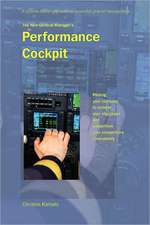Manage Your IT For Profit: Teach Yourself: Teach Yourself
Autor Michael Paganen Limba Engleză Paperback – apr 2010
NOT GOT MUCH TIME?
One, five and ten-minute introductions to key principles to get you started.
AUTHOR INSIGHTS
Lots of instant help with common problems and quick tips for success, based on the author's many years of experience.
TEST YOURSELF
Tests in the book and online to keep track of your progress.
EXTEND YOUR KNOWLEDGE
Extra online articles to give you a richer understanding of how to manage your IT.
FIVE THINGS TO REMEMBER
Quick refreshers to help you remember the key facts.
TRY THIS
Innovative exercises illustrate what you've learnt and how to use it.
Din seria Teach Yourself
-
 Preț: 66.94 lei
Preț: 66.94 lei -
 Preț: 52.30 lei
Preț: 52.30 lei - 25%
 Preț: 70.76 lei
Preț: 70.76 lei - 24%
 Preț: 52.58 lei
Preț: 52.58 lei - 22%
 Preț: 65.30 lei
Preț: 65.30 lei - 26%
 Preț: 78.21 lei
Preț: 78.21 lei - 26%
 Preț: 60.42 lei
Preț: 60.42 lei - 24%
 Preț: 232.90 lei
Preț: 232.90 lei - 24%
 Preț: 53.11 lei
Preț: 53.11 lei - 26%
 Preț: 50.69 lei
Preț: 50.69 lei - 24%
 Preț: 33.50 lei
Preț: 33.50 lei - 31%
 Preț: 137.91 lei
Preț: 137.91 lei - 25%
 Preț: 205.55 lei
Preț: 205.55 lei - 24%
 Preț: 52.48 lei
Preț: 52.48 lei - 25%
 Preț: 61.83 lei
Preț: 61.83 lei - 24%
 Preț: 52.74 lei
Preț: 52.74 lei - 29%
 Preț: 120.91 lei
Preț: 120.91 lei - 29%
 Preț: 119.23 lei
Preț: 119.23 lei - 24%
 Preț: 52.93 lei
Preț: 52.93 lei - 24%
 Preț: 52.48 lei
Preț: 52.48 lei - 25%
 Preț: 61.30 lei
Preț: 61.30 lei - 23%
 Preț: 114.05 lei
Preț: 114.05 lei - 30%
 Preț: 116.03 lei
Preț: 116.03 lei - 30%
![Complete Spanish, Beginner to Intermediate Course [With Paperback Book]: Sbas](https://i4.books-express.ro/bs/9781444177244/complete-spanish-beginner-to-intermediate-course-with-paperback-book.jpg) Preț: 140.76 lei
Preț: 140.76 lei - 25%
 Preț: 71.02 lei
Preț: 71.02 lei - 26%
 Preț: 200.62 lei
Preț: 200.62 lei - 30%
 Preț: 117.00 lei
Preț: 117.00 lei - 24%
 Preț: 52.93 lei
Preț: 52.93 lei - 24%
 Preț: 52.77 lei
Preț: 52.77 lei - 30%
 Preț: 116.49 lei
Preț: 116.49 lei - 24%
 Preț: 52.87 lei
Preț: 52.87 lei - 26%
 Preț: 77.69 lei
Preț: 77.69 lei - 25%
 Preț: 52.33 lei
Preț: 52.33 lei - 23%
 Preț: 73.25 lei
Preț: 73.25 lei - 24%
 Preț: 72.91 lei
Preț: 72.91 lei - 29%
 Preț: 142.38 lei
Preț: 142.38 lei - 23%
 Preț: 84.74 lei
Preț: 84.74 lei - 29%
 Preț: 142.40 lei
Preț: 142.40 lei - 24%
 Preț: 52.93 lei
Preț: 52.93 lei - 24%
 Preț: 52.62 lei
Preț: 52.62 lei - 23%
 Preț: 63.97 lei
Preț: 63.97 lei - 24%
 Preț: 62.33 lei
Preț: 62.33 lei - 23%
 Preț: 73.70 lei
Preț: 73.70 lei - 31%
 Preț: 135.48 lei
Preț: 135.48 lei - 23%
 Preț: 84.46 lei
Preț: 84.46 lei -
 Preț: 165.09 lei
Preț: 165.09 lei - 24%
 Preț: 52.48 lei
Preț: 52.48 lei - 24%
 Preț: 52.43 lei
Preț: 52.43 lei - 24%
 Preț: 72.71 lei
Preț: 72.71 lei - 29%
 Preț: 142.09 lei
Preț: 142.09 lei
Preț: 170.78 lei
Nou
Puncte Express: 256
Preț estimativ în valută:
32.68€ • 33.100$ • 26.98£
32.68€ • 33.100$ • 26.98£
Carte tipărită la comandă
Livrare economică 14-28 aprilie
Preluare comenzi: 021 569.72.76
Specificații
ISBN-13: 9781444107548
ISBN-10: 1444107542
Pagini: 222
Ilustrații: illustrations
Dimensiuni: 129 x 198 x 17 mm
Greutate: 0.23 kg
Ediția:New.
Editura: MOBIUS
Colecția Teach Yourself
Seria Teach Yourself
ISBN-10: 1444107542
Pagini: 222
Ilustrații: illustrations
Dimensiuni: 129 x 198 x 17 mm
Greutate: 0.23 kg
Ediția:New.
Editura: MOBIUS
Colecția Teach Yourself
Seria Teach Yourself
Notă biografică
Michael Pagan has many years' experience as an IT director/consultant and as a small business owner.
Cuprins
- : 1. Hardware - Outlines the main types of computing device and peripherals
- 2. Software: - Outlines software categories and the most popular products in each
- : 3.Joining it all up - Networks, the benefits and features of connecting computers together
- : 4.Communications - the world of phones, and wireless standards
- : 5.The Internet and E-Commerce - history, description, purpose and benefits of the World Wide Web
- : 6. Setting a Direction for Information - identifies how and why information can be used in an organisation, focusing on the human elements.
- : 7.Assessing Information Resources - how to analyse an organisation's ability to use information by examining the culture, management and technology of information
- : 8.Information Vision and Architecture - how to develop a broad view of where an organisation is going with information
- : 9.Information Strategy - how a company can achieve its information goals one step at a time
- : 10.The medium term plan - how to create a practical, workable roadmap to move your company ahead in its use of information
- : 11.The short term plan - how to create the immediate environment to succeed in your use of information
- 12. People: - recruiting a high performing IT team
- : 13. Business Continuity - protecting business critical systems
- : 14. Action! - example of strategy.
- : 15. Best practice - 20 ways to save money on your IT. 20 ways to add value through IT
- : 16.Glossary
- : 17. Bibliography
- : 18. Index
Descriere
Manage Your IT for Profit will help 'those who manage what they do not understand'! Written with humour and sound practicality, this guide is intended for the business owners and managers who need to understand the implications of technology in their business and to know how to utilise the information it provides to their maximum advantage and profit. It lessens the risk of your having the wool pulled over your eyes and reduces the fear of technology. Just as you need to understand balance sheets, profit and loss accounts and other financial metrics, you need to understand the language of IT.





















